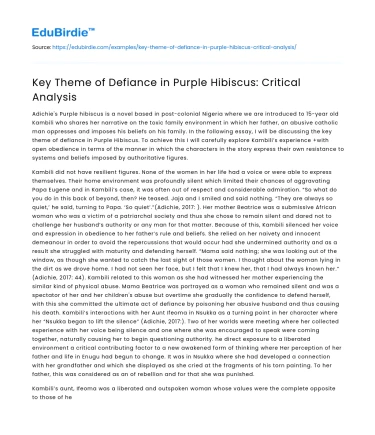Adichie's Purple hibiscus is a novel based in post-colonial Nigeria where we are introduced to 15-year old Kambili who shares her narrative on the toxic family environment in which her father, an abusive catholic man oppresses and imposes his beliefs on his family. In the following essay, I will be discussing the key theme of defiance in Purple Hibiscus. To achieve this I will carefully explore Kambili’s experience +with open obedience in terms of the manner in which the characters in the story express their own resistance to systems and beliefs imposed by authoritative figures.
Kambili did not have resilient figures. None of the women in her life had a voice or were able to express themselves. Their home environment was profoundly silent which limited their chances of aggravating Papa Eugene and in Kambili’s case, it was often out of respect and considerable admiration. “So what do you do in this back of beyond, then? He teased. Jaja and I smiled and said nothing. “They are always so quiet,’ he said, turning to Papa. ‘So quiet’.”(Adichie, 2017: ). Her mother Beatrice was a submissive African woman who was a victim of a patriarchal society and thus she chose to remain silent and dared not to challenge her husband’s authority or any man for that matter. Because of this, Kambili silenced her voice and expression in obedience to her father’s rule and beliefs. She relied on her naivety and innocent demeanour in order to avoid the repercussions that would occur had she undermined authority and as a result she struggled with maturity and defending herself. “Mama said nothing; she was looking out of the window, as though she wanted to catch the last sight of those women. I thought about the woman lying in the dirt as we drove home. I had not seen her face, but I felt that I knew her, that I had always known her.” (Adichie, 2017: 44). Kambili related to this woman as she had witnessed her mother experiencing the similar kind of physical abuse. Mama Beatrice was portrayed as a woman who remained silent and was a spectator of her and her children's abuse but overtime she gradually the confidence to defend herself, with this she committed the ultimate act of defiance by poisoning her abusive husband and thus causing his death. Kambili’s interactions with her Aunt Ifeoma in Nsukka as a turning point in her character where her “Nsukka began to lift the silence” (Adichie, 2017:). Two of her worlds were meeting where her collected experience with her voice being silence and one where she was encouraged to speak were coming together, naturally causing her to begin questioning authority. he direct exposure to a liberated environment a critical contributing factor to a new awakened form of thinking where Her perception of her father and life in Enugu had begun to change. It was in Nsukka where she had developed a connection with her grandfather and which she displayed as she cried at the fragments of his torn painting. To her father, this was considered as an of rebellion and for that she was punished.
Kambili’s aunt, Ifeoma was a liberated and outspoken woman whose values were the complete opposite to those of her parents. She served as Kambili’s representation of a woman who spoke up against the unjust and was able to confront and challenge her brother’s beliefs and authority. She also helped Jaja, and Kambili realise the faults in the way that their father chose to raise. Unlike Papa Eugene, Aunt Ifeoma showed respect towards both her religion and native tradition and honoured their father. Aunt Ifeoma worked as a professor at the university and was accused of encouraging students to engage in active protests. The visits to Nsukka gave Kambili and Jaja new freedom, hope, and a completely different perspective to a healthy home environment where their opinions were valued and not silenced. “Nsukka started it all; Aunty Ifeoma’s little garden next to the verandah of her flat in Nsukka began to lift the silence. Jaja’s defiance seemed to me now like Aunty Ifeoma’s experimental purple hibiscus: rare, fragrant with the undertones of freedom. […] A freedom to be, to do. ( ) Kambili witnessed that the experiences in Nsukka lead to a visible change in Jaja’s mental outlook and behaviour where he began to actively overstep his father’s set boundaries. Jaja became more outspoken and demanding, he would equally protect his mother and his sister when necessary.
Jaja had reached his breaking point and started to openly disobey his father “The next day was Palm Sunday, the day Jaja did not go to communion, the day Papa threw his heavy missal across the room and broke the figurines.” (Adichie, 2017: 253). Eugene was a strict catholic who used faith as tool to dictate the lives of his family, thus Jaja’s rejection of this faith was a strong symbol of defiance
Kambili’s father did not honour his father, Papa-Nnukwu who was a traditionalist that practiced the sacred traditions of the Igbo tribe. Eugene Achieke did not want to be associated with his father and regarded him as a ‘Godless’ man. He rejected all forms of tradition and limited his interactions with his father together with his family. There were a number of instances where Papa expressed defiance against his father’s beliefs for instance when he instructed mama Beatrice and Kambili not to bow to the ‘Igwe’ as he was merely a chief and that it was an ungodly tradition. He did not show any compassion towards his father upon his sickness or death and refused to be part of his father’s burial. Eugene later punished his children for being in the same house as his father by washing their feet in boiling water, he claimed that “That [was] what you [did] to yourself when you walk into sin. You burn[ed] your feet.’ (Adichie, 2017: ).






 Stuck on your essay?
Stuck on your essay?

